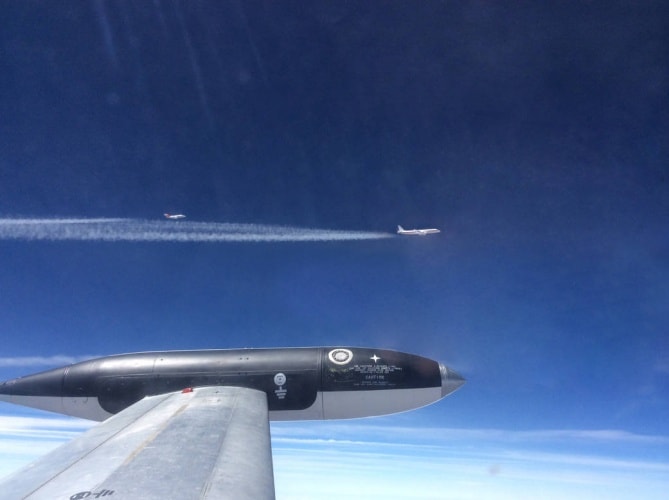A study from NASA has found that jet engines running on biofuels can reduce particle emissions by between 50 and 70 per cent.

(Credit: National Research Council of Canada)
Working alongside agencies from Germany and Canada, NASA carried out a series of flight tests in 2013 and 2014 using a four-engine DC-8 aircraft. Flying as high as 40,000 feet, the DC-8 burned a 50-50 blend of aviation fuel and an alternative renewable fuel of hydro-processed esters and fatty acids, produced from camelina plant oil. The tests were part of the Alternative Fuel Effects on Contrails and Cruise Emissions Study, or ACCESS.
Behind the DC-8, three research aircraft took turns directly trailing it at distances between 300 feet and over 20 miles, taking measurements on emissions and studying the plane’s contrails. Contrails are formed when hot jet exhaust mixes with the cold air at high altitudes, forming ice crystals around tiny particles of soot. Persistent contrails can form long-lasting cirrus clouds, which have a significant effect on the environment. According to NASA, aircraft contrails and the clouds they create have a bigger environmental impact than all aviation CO2 emissions since powered flight began.
"Soot emissions also are a major driver of contrail properties and their formation," said Bruce Anderson, ACCESS project scientist at NASA’s Langley Research Center in Hampton, Virginia.
"As a result, the observed particle reductions we’ve measured during ACCESS should directly translate into reduced ice crystal concentrations in contrails, which in turn should help minimise their impact on Earth’s environment."
NASA claims this is the first time that quantities of soot particles from jet engines using biofuels have been measured. As well as NASA’s HU-25C Guardian jet, the measurements were taken by a Falcon 20-E5 jet owned by the German Aerospace Center (DLR), and a CT-133 jet provided by the National Research Council of Canada.




Nanogenerator consumes CO2 to generate electricity
Whoopee, they've solved how to keep a light on but not a lot else.